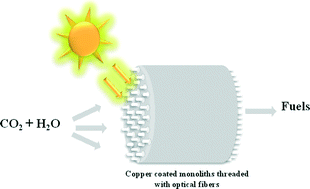Copper based TiO2 honeycomb monoliths for CO2 photoreduction
Abstract
The direct photoreduction of CO2via catalytic conversion of copper supported on TiO2 based monolithic structures is a means by which solar fuels can be produced. Copper based monolithic structures with varying loadings were synthesized through a sol–gel dip coating procedure and tested for CO2 reduction with H2O as a reductant in the gaseous phase. Results established that increased copper concentration can decrease crystalline size and promote anatase to rutile phase transformation. The coated monolithic structures were dominated by mainly Cu1+ species, as confirmed by XPS while bulk characterization suggests that these species are present in the crystal lattice via substitution of Ti4+ ions with Cu1+ ions. The catalytic performance of the Cu doped TiO2 monoliths for hydrocarbon formation was found to be considerably higher when compared to pure TiO2 under UVA or visible light irradiation.

- This article is part of the themed collection: Carbon dioxide conversion

 Please wait while we load your content...
Please wait while we load your content...